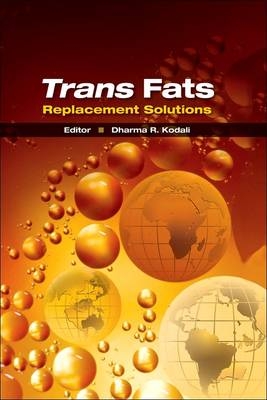
Trans Fats Replacement Solutions
Academic Press Inc (Verlag)
978-0-12-810380-7 (ISBN)
Dr. Dharma R. Kodali is a Research Professor in the Department of Bioproducts and Biosystems Engineering at the University of Minnesota. He received a PhD in synthetic medicinal chemistry in 1980 from Kurukshetra University, India. After a year of post-doctoral training at the Polytechnic Institute of New York University, he joined Boston University as a Staff Scientist and an Assistant Professor of Biophysics for 10 years, studying structurally defined lipid synthesis, molecular packing, physical properties, and their influence on metabolism. As a principal scientist and R&D manager for 13 years at Cargill, he championed new and value-added product development from fats/oils and agricultural materials for food and industrial applications. His research group developed and commercialized a number of innovative products. He worked for a year at General Mills as a Corporate Senior Principal Scientist developing trans fat alternatives, and then started a company, Global Agritech, to provide consultation to the industry. His current research interests include development of new and value-added bioproducts for industrial applications from fats/oils and lignocellulosic biomass. A new bioplasticizers technology from soybean oils developed by his group is being commercialized. Dr. Kodali has authored or co-authored 75 publications and book chapters and co-edited the AOCS book on Trans Fats Alternatives. He is an inventor or co-inventor of more than 25 patents. Dr. Kodali is a well-recognized expert in lipids and has given numerous invited lectures in number of international conferences. He has been an active member of the American Oil Chemists’ Society (AOCS) and the American Chemical Society (ACS) for more than 30 years. His accomplishments include Cargill’s Chairman’s Innovation Award in 2001, the ACS’s Industrial Innovation Award in 2002, and the AOCS T.L. Mounts award in 2003. He is an elected Fellow of AOCS and the American Institute of Chemists. He is a founding member and served as chair for the Industrial Oil Products division of AOCS, and a member of the AOCS Books and Special Publications Committee.
Preface
List of Abbreviations
Chapter 1: Trans Fats: Health, Chemistry, Functionality, and Potential Replacement Solutions
Introduction
Health Effects of Trans Fats
Structure, Properties, and Functionality of TAGs
Functional Need for Solid Fat in Food Products
Trans Fats Replacement Strategies
Designer Fats
Ideal Designer Fats for Solid Fat Applications
Summary
Acknowledgments
Chapter 2: Natural versus Industrial Trans Fatty Acids
Natural versus Industrial Trans Fats: Basic Hypothesis and Background
Natural versus Industrial Trans Fatty Acids: Chemistry and Dietary Sources
Analytical Considerations and Biomarkers of Intake
Impact of Natural and Industrial TFAs on Blood Lipid Profile and Coronary Heart Disease Risk
Public Health Implications
Chapter 3: FDA Food Labeling Regulations for Trans Fat
Introduction
Trans Fat in Nutrition Facts
Nutrient Content Claims
Health Claims
Latest Developments in Trans Fats Regulations
Similar International Trans Fat Labeling Regulations
Chapter 4: Nutritional Aspects of Trans Fatty Acids
Introduction
Characteristics of Trans Fatty Acids
Intake of Trans Fatty Acids
Trans Fatty Acids and Cholesterol
Trans Fatty Acids and Cardiovascular Disease
Trans Fatty Acids and Adiposity and Weight Management
Trans Fatty Acids and Diabetes and Insulin Resistance
Trans Fatty Acids and Cancer
Reduction of Intake of Trans Fatty Acids
Conclusion
Chapter 5: Application of Gas Chromatography and Infrared Spectroscopy for the Determination of the Total Trans Fatty Acid, Saturated Fatty Acid, Monounsaturated Fatty Acid, and Polyunsaturated Fatty Acid Contents in Edible Fats and Oils
Introduction
Capillary Gas Chromatography
Mid-Infrared Spectroscopy
Near-Infrared Spectroscopy
Conclusions
Chapter 6: Processing Solutions: Fractionation and Blended Oils
Introduction
Sources of Solid Fat Alternatives for Partially Hydrogenated Vegetable Oils
Palm Oil: The Most Versatile Solution to Trans Fat Reduction in Processed Foods
Component Blending to Match PHVO High Trans Shortenings and Fats
Formulating Palm Oil and Its Fractions for a Diverse Range of Functional Products
Summary and Conclusions
Chapter 7: High-Oleic Oils and Their Uses for Trans Fats Replacement
Introduction
Compositions and Properties
Chapter 8: Latest Developments in Chemical and Enzymatic Interesterification for Commodity Oils and Specialty Fats
Introduction
Random Interesterification for Commodity Oils
Specific Enzymatic Interesterification for Specialty Fat Products
Conclusions
Chapter 9: Enzymatic Interesterification
Introduction
Reaction Mechanism
Monitoring Method for the Process of Lipase-Catalyzed Interesterification Degree
Process Development for Lipase-Catalyzed Interesterification
Characterization of Lipase-Catalyzed Interesterified Fat
Crystal Microstructure
Chapter 10: Structured Emulsions and Edible Oleogels as Solutions to Trans Fat
1.1 Introduction and Recent Progress in Regard to Trans Fat Reduction
Effects of Specific Fatty Acids on Our Cardiovascular Health
Structured Emulsions Using Monoglycerides
Organogels
Waxes and Wax Organogels
Oleogels Made Using 12-Hydroxystearic Acid
Ethylcellulose (Polymer) Oleogels
Imaging the Polymer Network Structure of Ethylcellulose Oleogels
Production Considerations and Food Applications of Ethylcellulose Oleogels
Using Oleogels for Nutraceutical Delivery or Encapsulation
Phytosterol–Oryzanol Mixtures for Organogelation Purposes
Conclusion
Chapter 11: Trans Fats Replacement Solutions for Frying and Baking Applications, Shortenings, Margarines, and Spreads
Introduction
Blending as Zero Trans Options
Trait Modified Oils as Trans Fat Replacements
Case Studies on Trans Reformulation in Fast Food Chains and Laboratory Frying (Trait-Modified Oils)
Baking
Palm-Based Baking Shortenings
Troubleshooting Trans-Free Frying and Baking
Zero-Trans Margarines and Spreads
Conclusion
Chapter 12: Trans Fats Replacement Solutions in North America
Introduction
Consumption Patterns: Effect of Trans Fat Labeling
Food Service Applications and Products
Trans Fat Regulation in Canada
Commercial Trans Fat Replacements
Innovations in Trans Fat Replacements in the Food Service Sector
Other Trans Fat Alternatives
New Low-Saturate/No-Trans, Omega-3-Enriched Oils in the Commercial Pipeline
Margarines and Spreads
Chapter 13: Trans Fats Replacement Solutions in Europe
Introduction
TFA Intake in Europe
TFA in Foods in Europe
Trans Fat Regulations in Europe
Why Industrial TFAs Were Used in Food Products in Europe
Low Trans Partial Hydrogenation
Elimination of Partially Hydrogenated Vegetable Oils as Structurants from Fat-Continuous Margarines and Spreads
Replacement of Partially Hydrogenated Vegetable Oil as a Cocoa Butter Alternative
Replacement of Partially Hydrogenated Vegetable Oil in Stable Frying Oils
Conclusion
Chapter 14: Trans Fats Replacement Solutions in South America
The Hydrogenation Process in Brazil and Argentina
Trans Fat Free Americas
Regulation of Trans Fats in Brazil and Argentina and Intake Recommendation
Trans Fatty Acid Content of Brazilian and Argentinean Foods Before and After Mandatory Trans Fat Labeling
Alternatives to Reduce Trans Fat in Foods
Chapter 15: Trans Fats Replacement Solutions in China
Introduction
Labeling and the Regulatory Situation
Industrial Responses and Solutions
Technical Trends in Industry
Remarks and Outlook
Chapter 16: Trans Fats Replacement Solutions in Japan
Introduction
Ingested Amount of TFA in Japan
Response to the TFA Issue in Japan
Reduction Measures of TFA
Future Prospects
Chapter 17: Trans Fats Replacement Solutions in India
Introduction
History of the Vanaspati Industry in India
Vegetable Oils Used for the Manufacture of Vanaspati
Fatty Acid Composition of Indian Vanaspati
Vanaspati Manufacturing Process
Trans Fats in the Indian Diet
Trans Fatty Acid Consumption of the Indian Population
Vanaspati Regulations in India
Methods to Reduce TFA Content in Vanaspati/Bakery Shortening
Conclusions
Chapter 18: Trans Fats Replacement Solutions in Malaysia
Introduction
Regulation of Trans Fatty Acids in Malaysia
Recommended Nutrient Intake for Trans Fatty Acids in Malaysia
Trans Fatty Acid Content of Malaysian Food Products
Trans Fat Alternatives
Versatility of Palm Oil Fractions in Food Applications
Chapter 19: Trans Fats Replacement Solutions in Australia and New Zealand
Introduction
TFA in Foods in Australia and New Zealand
Trans Fat Regulations in Australia and New Zealand
Strategies for Trans Fat Replacement
Conclusion
Index
| Erscheinungsdatum | 07.09.2016 |
|---|---|
| Verlagsort | San Diego |
| Sprache | englisch |
| Maße | 152 x 229 mm |
| Gewicht | 750 g |
| Themenwelt | Sachbuch/Ratgeber ► Gesundheit / Leben / Psychologie ► Ernährung / Diät / Fasten |
| Naturwissenschaften ► Chemie ► Analytische Chemie | |
| Technik ► Lebensmitteltechnologie | |
| ISBN-10 | 0-12-810380-9 / 0128103809 |
| ISBN-13 | 978-0-12-810380-7 / 9780128103807 |
| Zustand | Neuware |
| Haben Sie eine Frage zum Produkt? |
aus dem Bereich


